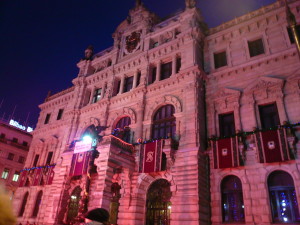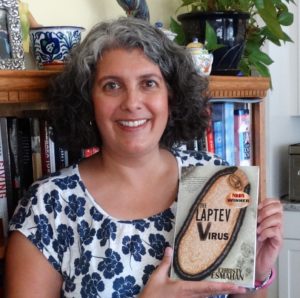It’s July, and the summer months in Spain are a time of celebration. As the Spanish characters in my book demonstrate to the American ones, Spain is a great place for fiestas, parties, lasting from a few days to an entire week, held on or around the patron saint day of every city or pueblo (small town) across the country. If you happen to be travelling in Spain this summer, check out when the local fiestas are, and go see the pueblo light up with music, dancing, special foods, bright decorations, parades and, often, bulls.
One of questions I’m asked most frequently about my years living in Spain is whether I ever made it to see a bull fight. No, I did not, and neither have most of my Spanish friends, however, every morning from July 1st to the 7th, the TV had to be on to watch the cows running through the streets of Pamplona, in preparation for the week’s festivities. It’s an amazing site which takes place in the early hours, with large numbers of men, young and old, running through the streets, closely followed by the horned bovine mob. Yes, there are ambulances on the side streets, waiting to whisk anyone who is pierced in the leg (or, ouch, elsewhere) to a hospital. And, perhaps you won’t be surprised to learn that most of the people hurt every year are: a) drunk and b) foreigners. The secret to not getting hurt, a friend explained to me many years ago, is to not try to run for very long in front of the bulls; the Spaniards know to run for just a few seconds, and then dodge out of the way, while the foreigners, predominantly British, Germans and Americans who have been up partying all night, try to run the entire track through the city in front of the cows, and thus, unfortunately, every year there are those who have more than just good memories to show for their fun times in Spain.
But back to Pamplona: there is a song which every Spaniard learns as a small child, which I taught my students in Spanish class, and which is the theme song for one of Spain’s most famous fiestas: San Fermin . It’s a great way to learn the first seven months of the year and their corresponding numbers, and it commemorates the fact that the fiestas of Pamplona, San Fermin, are the first seven days of July. It goes:
Uno de enero, dos de febrero,
tres de marzo, cuatro de abril.
Cinco de mayo, seis de junio,
siete de julio, San Fermin.
Bilbao, a larger city which some of my characters explore, lies hugging the coast, just east of Santander. Since most of its residents are on vacation in August, the city pretty much empties out, and it’s a wonderful time to be there, sipping a glass of Rioja wine at an outdoor terrace. But in mid-August the fiestas begin, and you can hear the drums beating, smell the lovely foods cooking and see the bright flags all over the city. I used to especially love to watch the regional Basque dancing which is centuries old and not at all related to the flamenco dancing that we usually attribute to Spain. The men, wearing white pants and a white shirt, a red sash across their waist, and a red scarf around their necks, perform complicated jumps while knocking long sticks together to the beat of the music. The women have on black, longish skirts and white shirts, and they often dance forming large circles which spin in one direction for a few steps, and then turn the other way, while the dancers hold their arms aloft and perform complicated patterns with their feet.
So off you go, have fun at the fiestas and if you have too much to drink, please don’t try to run in front of the bulls!!
Link to You tube San Fermin song:
Links to typical Basque dancing. First some women: Then some men with small sticks Followed by some nice couples dancing with arches
If you enjoyed this blog post, you might also like my series of novels, Bueno, Sinco and Brujas, which takes place in Santander, Spain.




1 pings
[…] one about Santiago de Compostela, on occasion of the horrible train crash, one about the fiestas in Pamplona, Bilbao and other parts of Spain, and one about a mansion in Santillana del Mar, […]